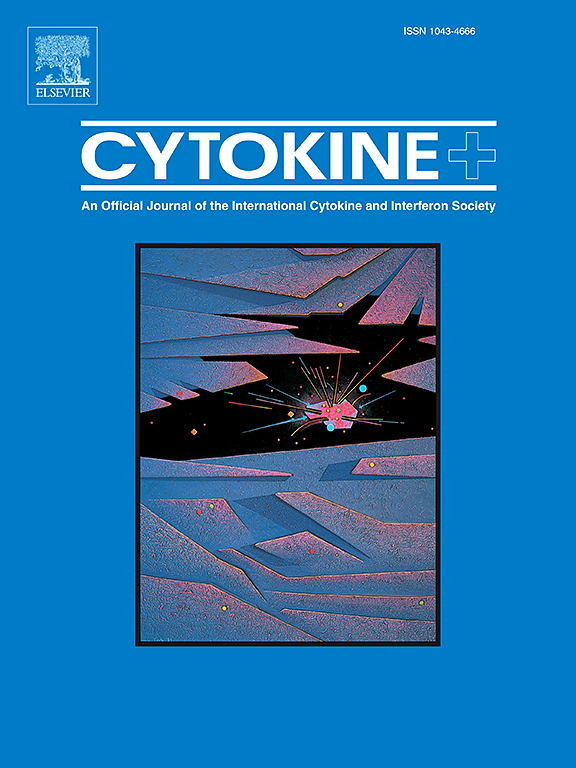Transforming growth factor beta induces interleukin-11 expression in osteoarthritis
IF 3.7
3区 医学
Q2 BIOCHEMISTRY & MOLECULAR BIOLOGY
引用次数: 0
Abstract
Interleukin-11 (IL-11) is a member of the IL-6 family of cytokines and possesses both pro- and anti-inflammatory properties. IL-11 activates its target cells via binding to a membrane-bound IL-11R and subsequent formation of a homodimer of the signal-transducing receptor gp130. Thus, the expression pattern of the IL-11R determines which cells can be activated by IL-11. However, knowledge about IL-11 target cells and cells that secrete IL-11 are sparse, and the overall roles of IL-11 in inflammatory diseases are largely unexplored. In this study, we show that high amounts of IL-11 can be detected via ELISA in the synovial fluid of osteoarthritis (OA) patients in comparison to rheumatoid arthritis (RA) patients. Using primary cells and tissue of OA patients, we show that IL-11 is expressed by chondrocytes in cartilage, but not in the synovium. We further identify the cytokine transforming growth factor β 1(TGF-β1) as a potent inducer of IL-11 secretion in both primary chondrocytes and fibroblasts, and TGF-β1 and IL-11 levels correlate significantly in the synovial fluid of OA patients. Using immunohistochemistry, we show that both cartilage and synovium express IL-11R, and the amount of IL-11R is independent of the disease severity. Primary chondrocytes and fibroblasts from OA patients respond to IL-11 stimulation with potent activation of the Jak/STAT3 signaling cascade, suggesting that these cell types are not only the source, but also the targets of IL-11 in OA patients. Our results uncover IL-11 as a potential new target for therapy in OA.
转化生长因子β诱导骨关节炎中白细胞介素-11的表达。
白细胞介素-11 (IL-11)是IL-6细胞因子家族的一员,具有促炎和抗炎特性。IL-11通过与膜结合的IL-11R结合并随后形成信号转导受体gp130的二聚体来激活其靶细胞。因此,IL-11R的表达模式决定了哪些细胞可以被IL-11激活。然而,关于IL-11靶细胞和分泌IL-11的细胞的知识很少,IL-11在炎症性疾病中的整体作用在很大程度上未被探索。在这项研究中,我们发现与类风湿关节炎(RA)患者相比,在骨关节炎(OA)患者的滑液中可以通过ELISA检测到大量的IL-11。利用OA患者的原代细胞和组织,我们发现IL-11在软骨中的软骨细胞中表达,而在滑膜中不表达。我们进一步发现细胞因子转化生长因子β1 (TGF-β1)是原发性软骨细胞和成纤维细胞分泌IL-11的有效诱导剂,TGF-β1和IL-11水平在OA患者的滑液中显著相关。通过免疫组化,我们发现软骨和滑膜都表达IL-11R, IL-11R的表达量与疾病的严重程度无关。OA患者的原代软骨细胞和成纤维细胞对IL-11刺激的反应是Jak/STAT3信号级联的有效激活,这表明这些细胞类型不仅是OA患者IL-11的来源,也是IL-11的目标。我们的研究结果揭示了IL-11作为OA治疗的潜在新靶点。
本文章由计算机程序翻译,如有差异,请以英文原文为准。
求助全文
约1分钟内获得全文
求助全文
来源期刊

Cytokine
医学-免疫学
CiteScore
7.60
自引率
2.60%
发文量
262
审稿时长
48 days
期刊介绍:
The journal Cytokine has an open access mirror journal Cytokine: X, sharing the same aims and scope, editorial team, submission system and rigorous peer review.
* Devoted exclusively to the study of the molecular biology, genetics, biochemistry, immunology, genome-wide association studies, pathobiology, diagnostic and clinical applications of all known interleukins, hematopoietic factors, growth factors, cytotoxins, interferons, new cytokines, and chemokines, Cytokine provides comprehensive coverage of cytokines and their mechanisms of actions, 12 times a year by publishing original high quality refereed scientific papers from prominent investigators in both the academic and industrial sectors.
We will publish 3 major types of manuscripts:
1) Original manuscripts describing research results.
2) Basic and clinical reviews describing cytokine actions and regulation.
3) Short commentaries/perspectives on recently published aspects of cytokines, pathogenesis and clinical results.
 求助内容:
求助内容: 应助结果提醒方式:
应助结果提醒方式:


